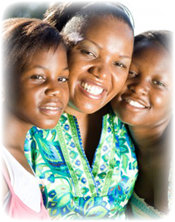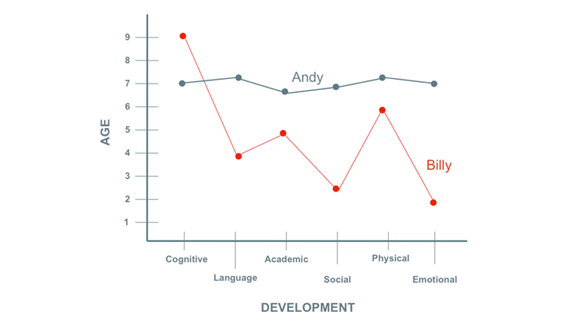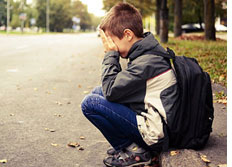Reclaiming the Love for Learning
|
|||||||||||||
|
Childhood trauma happens at both the emotional and psychological level
and it can have a negative impact on the child's developmental process.
During a traumatic event (abuse, neglect, adoption, accidents, birth
trauma, etc.), the lifelong impact is even greater if the child believes
he powerless, helpless, and hopeless. When a child experiences one or
all of these feelings, he begins to believe the world is dangerous.
Repeated experiences of these feelings will create a lasting imprint
from which he operates and behaves. A framework based in fear and
survival becomes the child's viewpoint of the world around him.
These early life experiences then influence the child's ability to "behave," or more correctly expressed, the child's ability to stay "regulated." Trauma impacts a child's ability to stay calm, balanced, and oriented. Instead, children with traumatic histories often find themselves in a "dysregulated" state, which manifests into a child who does not behave, cannot focus, and/or lacks motivation. It is not a matter of choice or a matter of "good" child verses "bad" child; it is simply an imprint from the child's past history. It's the child's new normal. When working with children like this in the classroom, the most effective way to work with them is to work at the level of regulation, relationship, and emotional safety instead of at the level of behavior. These children's issues are not behavioral; they are regulatory. Working at the level of regulation, relationship, and emotional safety addresses more deeply critical forces within these children that go far beyond the exchanges of language, choices, stars, and sticker charts. Traditional disciplinary techniques focus on altering the left hemisphere through language, logic, and cognitive thinking. These approaches are ineffective because the regulatory system is altered more effectively through a different part of the brain known as the limbic system. The limbic system operates at the emotional level, not at the logical level. Therefore, we must work to regulate these children at the level of the limbic system, which happens most easily through the context of human connection. When the teacher says to a non-traumatized child, "Andy, can you please settle down and quietly have a seat?" Andy has the internal regulatory ability to respond appropriately to his teacher because trauma has not interrupted his developmental maturation of developing self-regulation tools and feeling like he is safe in the world. However, when Billy (the traumatized child) is asked the same question, his response is much different. He takes the long way around the classroom to his seat, he continues to not only talk but projects his voice across the room as if he is still out in the playground, and once seated continues to squirm and wiggle. Traditionally, we have interpreted Billy as a disruptive child, pasted the label ADHD (attention deficit hyperactivity disorder) onto him, and reprimanded him for his "naughty" behavior. What we have failed to see is that Billy cannot settle down on his own. His internal system has not experienced the appropriate patterning to know how to be well behaved like his classmate Andy and Billy does not know he is safe in this world, even if he is now in a safe environment. The brain-body system is a pattern-matching machine. A child with little internal self-control will pattern himself according to his past external experiences. If his past experiences have been chaotic, disruptive, and overwhelming (trauma), he will continue acting this way until new patterns are established. Thus, a child coming into a calm and safe classroom is still likely to be acting as if he is in his previous chaotic and unsafe environment. A child can be taken out of trauma but not so easily can the trauma be taken out of the child. Past patterns of chaos are now the current framework for navigating his world; he knows no different. The most effective way to change these patterns comes through safe, nurturing, attuned, and strong human connection. For the student in the classroom, it comes through the teacher-student relationship. The reality is, for our traumatized children to learn and achieve academically, science is showing that they must be engaged at the relational level prior to any academic learning. Press on, |
|||||||||||||
 |
|||||||||||||
| Heather T. Forbes, LCSW Parent and Author of Beyond Consequences, Logic & Control: Volume 1 & Volume 2, Dare to Love, and Help for Billy. | |||||||||||||
Tuesday, February 24, 2015
Reclaiming the Love of Learning
Tuesday, February 17, 2015
When Siblings Become Traumatized
 | |||||||
| Q: For the past three years, our 16-year-old daughter, Jackie, has had to deal with the complete chaos of her younger adopted sister who was severely traumatized before we adopted her. Jackie was an only child before my husband and I adopted and my world revolved around Jackie. We lived a relatively peaceful, fun, and happy life. All of that drastically changed once her sister entered our family. I realize now that Jackie has been traumatized by the disruption, fear, and struggles our family has endured. What can I do to help my daughter, without dismissing the trauma she has gone through? | |||||||
A: You're exactly right when your say Jackie's trauma of living with a severely traumatized younger sister cannot be dismissed. In fact, her experience needs to be maximized and brought to the surface in order for her to find healing. Jackie needs the emotional space to be heard and to be understood. However, listening to your daughter's challenges can easily evoke feelings of guilt, shame, and perhaps, resentment in you. When this happens, all too often, parents inadvertently stop listening and work to minimize or stop their child's pain, closing off this child's needed opportunity to have a voice. The first place to start is to realize that you cannot fix Jackie's experiences from the past three years. What is, is. Yet, what you can do is work to understand her experiences (getting into her shoes) and giving her the time, patience, and emotional space to discharge ALL of her feelings. It takes being willing to commiserate with her and allowing her to express her story, not just at the cognitive level, but at the emotional level. Absorbing her pain means not responding in a defensive or a minimizing manner and not giving her solutions for the moment (that can come later). A conversation might sound something like this: Mom: "Sweetheart, there is something that I haven't recognized about your life. I haven't seen how difficult it has been for you since your sister came home. For the last three years, especially when she came home, I probably ignored you sometimes, I didn't pay the same amount of attention to you, and I wasn't there for you." This conversation might need to continue for a while, each time with mom "dancing" with whatever her daughter says in return, allowing her daughter to lead the conversation. Yet, the most important part of such a dialogue is that it happens with emotional intensity, at the heart level. Allowing Jackie the safety of a parent who is present and working to just listen, will allow her to discharge her anger, pain, and frustration now and not in the heat of a difficult moment when her sister is melting down. But perhaps you are saying that you've tried this and these types of conversations happen over and over without movement forward. If this is the case, then you have to dig deeper. Are you stopping your daughter at any level? Are you really able to handle her anger and pain? What feelings inside of you are coming up when she is expressing? Guilt? Fear of the future? Helplessness? Feeling the depth of your child's pain in these moments, coupled with your own dark feelings that have not been honored or expressed, will shut you down. Your daughter will feel this. Thus, her expression is not being heard and she stays stuck in her healing process. When this is the case, conversations like the one above will keep looping and looping, keeping everyone in a state of victimhood. You have to allow your pain to be felt, honored, and understood. In order for you to feel your child's pain, you have to feel your own pain first. This can be scary. It may seem that if you feel the depth of pain within you, opening up the floodgates, you won't be able to parent effectively and you won't be able to pull it together. Ironically, this is exactly what keeps parents from being able to parent the way their children need them to. Parents have to go deep within the caverns of their own hearts. They have to own and acknowledge their own pain. Parents have to stay in their hearts; that is where their children are living. Effective parenting ultimately comes from self-love, self-discovery, and self-understanding. Love yourself through your pain in order to get to the depth of your child's pain. Healing resides within this powerful dynamic. And remember, it isn't always about "fixing" the situation with your child. The "fixing" comes from listening, giving your child a voice, and simply being present. Press on, |
|||||||
| Heather T. Forbes, LCSW Parent and Author of Beyond Consequences, Logic & Control: Volume 1 & Volume 2, Dare to Love, and Help for Billy. | |||||||
Tuesday, February 10, 2015
Compassion Leads to Happiness
 |
Q: I have two children who
have been a constant struggle for the past 8 years. Each suffered
emotional and physical abuse, as well as neglect for the first 3 or 4
years of their lives. Our whole family continues to spiral and loop in a
pool of frustration, chaos, and tension. I’ve never been so unhappy in
my entire life and I find myself unable to be as compassionate at this
point. A: My experience has shown that much of the loss of happiness with parents raising challenging children is due to the loss of compassion. Research has linked the state of happiness to one’s ability to be compassionate. In a study using EEG and FMRI’s, researchers studied a highly trained monk. They first measured the brain of the monk in a resting state to generate baseline brain activity. Then the monk was asked to perform an intensive meditation on compassion. The results showed that during this state of compassion, there was a dramatic shift in his prefrontal function, lighting up the “happiness” region of the brain. | |||||||||||
Just the thought of being compassionate can evoke feelings of happiness. When we are concerned and connected to others, we have a sense of well being within ourselves. Unfortunately, most parenting approaches are grounded in a belief that if the child is obedient and well behaved, then the parent can be happy and the family is functioning. This approach places all of the responsibility onto the child and I deeply believe this is unhealthy and creates a dysfunctional family system. It is never the child’s responsibility to make the parent happy nor can the child's behavior be used to determine the health of the family system. Many problems in a family are caused at the most fundamental level by distortions of perception and negative interpretations of situations. It takes changing to a new perspective and for the parents to take responsibility for their state of emotions, despite the behavior of their children. One antidote to this begins with understanding the very nature of early childhood trauma (developmental trauma) and the lifelong effects it has on our children. Trauma never goes away completely. Be sure to educate yourself from the child’s perspective as to why they do what they are doing and what it means to live in a perpetual state of fear and overwhelm (My OnDemand parenting class is a great way to get yourself into this place of understanding for your children and it is available for immediate download: www.beyondconsequences.com/ondemand/parenting.php). A new perspective of your children can return you back to a place of compassion. Compassion will then return you back to a place of joy, amusement, and happiness. Compassion is essential to our well-being…it is the pinnacle of human emotions. Compassion is the openness to the suffering of another, combined with the wish that they be freed from their suffering. It moves us to be understanding, kind, affectionate, tolerant, warm-hearted, and caring. Compassion is love. Research shows that individuals are more likely to experience compassion for those who they perceive as similar to them in some way. If you can relate to your children’s struggles, rather than view them as outright disobedient or disrespectful, you will be more apt to help them move past their struggles and be more effective in creating an environment of healing. Most importantly, if your family is in a negative spiral, you have the ability to pull out of this vortex. It doesn’t have to hold you captive. There is now substantial evidence that shows we can train our minds to overcome negative emotions. We can be in charge of our happiness, despite our life circumstances. The amygdala is involved with anxiety and fear, which creates the feeling of unhappiness. However, studies have shown that you can counteract the reaction of the amygdala…you’re not powerless anymore! You have the ability to make your life work for you. It takes regaining hope and a practice of compassion. The next time you begin to feel overwhelmed or realize you’re unhappy, say to yourself, “I’m not powerless anymore.” Change your pattern. Don’t allow your child’s negative state to fire your amygdala. Don’t allow him to shift you into stress and fear. Don't give up your personal power anymore. Just give it a try! Love is available in all circumstances and at any moment of any day. There is a way to help your children get beyond the negative behaviors and remain happy at the same time! Press on, |
||||||||||||
 |
||||||||||||
| Heather T. Forbes, LCSW Parent and Author of Beyond Consequences, Logic & Control: Volume 1 & Volume 2, Dare to Love, and Help for Billy. | ||||||||||||
Tuesday, February 3, 2015
Is my child 16 years old or 2 years old?
| Q: My seven year old son has a history marked by trauma and while I understand this has set him up to act differently, I still find myself so frustrated with him! On one hand, he is so intelligent and gifted (his teacher describes him as "more gifted than the gifted kids"), yet on the other hand, he can't seem to comprehend what I say to him (or he just plain isn't listening to me!). He seems so mature intellectually yet acts like a two year old when things don't go his way. How do I parent a child who is 16 years old one minute and a two year old the next? It's maddening! | ||||||||
A: Children who are raised in predictable environments with consistent caretaking experience the world as both safe and good. They learn to trust themselves and to trust their emotions. They trust others and the world at large. They develop confidence in their ability to think and feel, no matter the situation at hand. However, children who are traumatized by abuse, neglect, and/or abandonment, do not develop such a coherent set of coping skills. They may spend all their resources and energy making certain they are safe since the caretakers around them are not. The lack of consistency and unpredictability in their lives interrupts their normal path of development. To demonstrate this, let's compare two children. First we have "Andy." Andy grew up in a nurturing and structured home. In fact, Andy’s womb experience was ideal. His mother took her prenatal vitamins, she exercised, she modulated her stress level, and she wanted to be pregnant and become a mother. Thus, by the time Andy is seven years old, he has reached his normal developmental milestones and is a high functioning, happy, and lovable child. Billy, on the other hand, has a history of abandonment, rejection, and unpredictability in his history. His mother didn't even want to be pregnant to begin with, so Billy entered the world feeling rejected and unwanted. At the age of seven years old, Billy is disorganized in his ability to navigate the world. He is capable in some areas yet shows massive deficits in other areas. Billy's development has been severely impacted by his life experiences. Here's a graph showing the difference between Andy's developmental path and Billy's developmental failures: |
||||||||
 |
||||||||
Here are six areas of development to consider for your child:
Children need to be accepted for who they are and for what their life experiences have created within them. Unconditional love requires us to get out of our own fears of "babying" our child in order to meet our child exactly at his developmental age. Be honest with yourself and objectively determine the actual capabilities of your child. When you are able to meet your child at his/her level of development, you are opening up the door to healing. Your child will feel more accepted, understood, and validated. This allows love to flow and for the parent/child relationship to be rebuilt. It is in the context of your loving relationship with your child that the graph of Billy can soon look closer to that of Andy. Children are resilient and are neurologically flexible. Healing, and thus behavioral change, takes a willingness to see a child for exactly who he is and to stop expecting him to be like the example of Andy, especially if the child has a traumatic history. For more information and an in-depth look at developmental trauma, click HERE to access my latest DVD series at a special internet price. Press on, |
||||||||
 |
||||||||
| Heather T. Forbes, LCSW Parent and Author of Beyond Consequences, Logic & Control: Volume 1 & Volume 2, Dare to Love, and Help for Billy. | ||||||||
Labels:
beyond consequences,
choose love,
parenting,
trauma
Subscribe to:
Comments (Atom)


